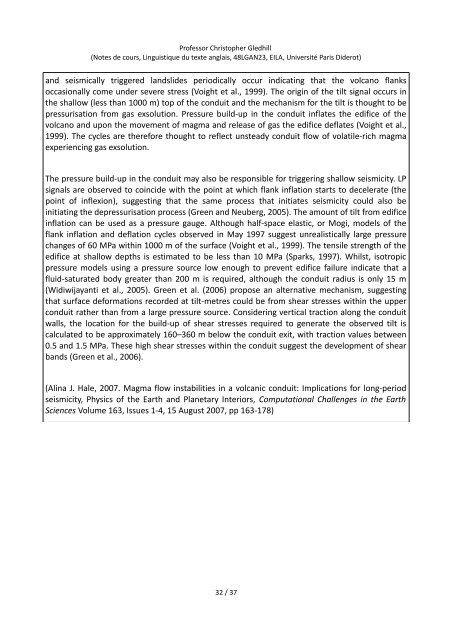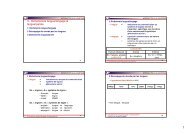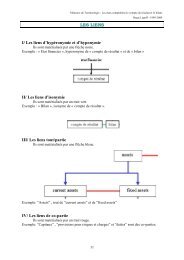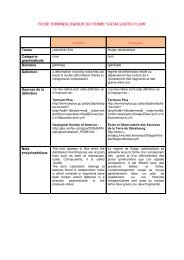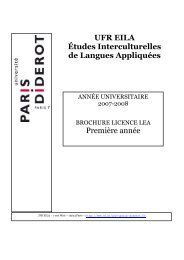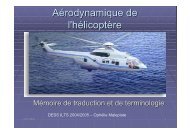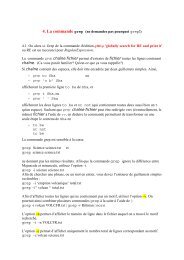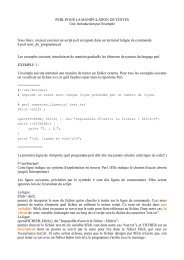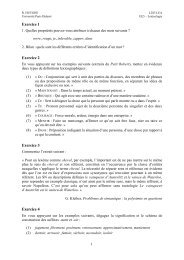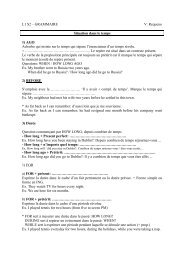INTRODUCTION TO ENGLISH TEXT LINGUISTICS
INTRODUCTION TO ENGLISH TEXT LINGUISTICS
INTRODUCTION TO ENGLISH TEXT LINGUISTICS
You also want an ePaper? Increase the reach of your titles
YUMPU automatically turns print PDFs into web optimized ePapers that Google loves.
Professor Christopher Gledhill<br />
(Notes de cours, Linguistique du texte anglais, 48LGAN23, EILA, Université Paris Diderot)<br />
and seismically triggered landslides periodically occur indicating that the volcano flanks<br />
occasionally come under severe stress (Voight et al., 1999). The origin of the tilt signal occurs in<br />
the shallow (less than 1000 m) top of the conduit and the mechanism for the tilt is thought to be<br />
pressurisation from gas exsolution. Pressure build-up in the conduit inflates the edifice of the<br />
volcano and upon the movement of magma and release of gas the edifice deflates (Voight et al.,<br />
1999). The cycles are therefore thought to reflect unsteady conduit flow of volatile-rich magma<br />
experiencing gas exsolution.<br />
The pressure build-up in the conduit may also be responsible for triggering shallow seismicity. LP<br />
signals are observed to coincide with the point at which flank inflation starts to decelerate (the<br />
point of inflexion), suggesting that the same process that initiates seismicity could also be<br />
initiating the depressurisation process (Green and Neuberg, 2005). The amount of tilt from edifice<br />
inflation can be used as a pressure gauge. Although half-space elastic, or Mogi, models of the<br />
flank inflation and deflation cycles observed in May 1997 suggest unrealistically large pressure<br />
changes of 60 MPa within 1000 m of the surface (Voight et al., 1999). The tensile strength of the<br />
edifice at shallow depths is estimated to be less than 10 MPa (Sparks, 1997). Whilst, isotropic<br />
pressure models using a pressure source low enough to prevent edifice failure indicate that a<br />
fluid-saturated body greater than 200 m is required, although the conduit radius is only 15 m<br />
(Widiwijayanti et al., 2005). Green et al. (2006) propose an alternative mechanism, suggesting<br />
that surface deformations recorded at tilt-metres could be from shear stresses within the upper<br />
conduit rather than from a large pressure source. Considering vertical traction along the conduit<br />
walls, the location for the build-up of shear stresses required to generate the observed tilt is<br />
calculated to be approximately 160–360 m below the conduit exit, with traction values between<br />
0.5 and 1.5 MPa. These high shear stresses within the conduit suggest the development of shear<br />
bands (Green et al., 2006).<br />
(Alina J. Hale, 2007. Magma flow instabilities in a volcanic conduit: Implications for long-period<br />
seismicity, Physics of the Earth and Planetary Interiors, Computational Challenges in the Earth<br />
Sciences Volume 163, Issues 1-4, 15 August 2007, pp 163-178)<br />
32 / 37


